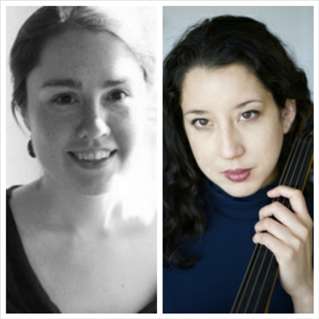|
Back
Light, Darkness and All in Between New York
Symphony Space
12/13/2013 -
Witold Lutoslawski: Bukoliki for viola and cello – Sacher Variation for solo cello – String Quartet
Steven Stucky: Nell'ombra, nella luce for string quartet – Dialoghi for solo cello
Acme String Quartet: Caroline Shaw and Caleb Burhans (Violins), Nadia Sirota (Viola), Clarice Jensen (Cello)
Laura Kaminsky (Compere with Steven Stucky) 
W. Lutoslawski/S. Stucky
(© W. Pniewski and L. Kowalski/Hoebermann Studio)
The Polish Cultural Institute made a nominally curious choice by pairing a centennial year tribute to the great Polish composer Witold Lutoslawski with a Texas-born composer, Steven Stucky But this choice was so very natural. Not only is Mr. Stucky one of our most eminent composers, but Lutoslawski was a friend and mentor. Moreover, Mr.Stucky had written the most definitive book in English on Lutoslawski and his Music, and is a consultant to all things...er...Lutoslawskian.
Thus, the concert consisted of two pieces for solo cello (one from each composer), two string quartets (ditto) and a work arranged for viola and cello from some simple piano works by Lutoslawski.
“The reason for that,” explained Mr. Stucky, “is that the Polish government at the time wouldn’t permit Lutoslawski’s ‘advanced’ music to be played, so he had to write works for children, film scores, other music.”
Even more ironic is that Lutoslawski often had to write under a pseudonym, just as the Hollywood writers targeted by Joseph McCarthy, made a living with their own noms de cinema.
Fascist-thought parades under infinite banners.
What the Government hadn’t realized as that by excoriating one of their finest composers, they obviously let the inspirations germinating inside him transform his music. Starting with a neoclassical style, he transformed the music with a “controlled degree of chance”, allowing musicians to exercise–like humans under Cosmic Laws–a limited degree of free will.
Today, the symphonies, Venetian Games and Funeral Music are amongst his most acclaimed works. But within the Lutoslawski catalogue are the rare chamber works played last night. The interesting thing here was that the Acme String Quartet itself is more than simply a group of performers.

C. Shaw/C. Jensen (© New Amsterdam Records/Liz Linde)
Caroline Shaw and Caleb Burhams are both eminent composers in their own right, Ms. Shaw having being the youngest recipient of the Pulitzer Price. And cellist Clarice Jensen was soloist in three of the works played last night.
In the first, Bukoliki, Ms Jensen and violist Nadia Silota played Lutoslawski “bucolics”, which had the two-part simplicity–and the complexity–of Stravinsky’s pieces for children. Five minutes of the young technician at work, including even a jazz-inspired third movement.
Ms. Jensen’s first solo was, like her second solo, Lutoslawski’s Sacher Variation, written with the name in the title. Conductor Paul Sacher was celebrated with a music which lost itself transfiguring the name with a sort of organic regeneration of the name.
That was a feat worthy of respect. More personal was Mr. Stucky’s solo cello piece for the American cellist Elinor Frey. Dialoghi was indeed a set of easily definable variations, and Ms. Jensen’s worked all the color and Italianate lyricism of the composer’s painless paean.
Mr. Stucky is that very exceptional composer whose music is beautiful, accessible, extremely cosmopolitan, yet follows no pre-approved “school.” In fact, while nothing descends to the purely emotional, his music does have an emotional context which comes out even in this work for a solo instrument.
His orchestral works are always interesting, but the string quartet last night, In Shadow, In Light, was an extreme experience. I had never heard it before, but the effect was simultaneously edgy and comforting. The edginess came from the appositions of joyousness and the titular shadows. They jolted against each other, sent out sparks and descended into darkness. The harmonies too were surprising, going from the most lovely consonance to dissonances, never quite staying the same place.
Structurally, it had a sort of four-movement architecture, but that was secondary to the virtually pictorial study he made of light and darkness. Not as a yin-yang or Manichean apposition, but, as in a dark room with a door halfway open, shadows and sharp lights found in unexpected corners.
In fact (and Mr. Stucky might not like this), I found far more in his string quartet than Lutoslawski’s sole String Quartet. The composer apparently wrote it after listening to music of John Cage, but the two inspirations don’t exactly fit.
It starts with a “fragmented monologue” single notes played almost arbitrarily, and possibly with some of those controlled aleatory section (though the aleatory sections are hidden in the ensemble ferocity). The following movements are fast, strenuous, a gathering of forces not anarchic, but with a sense of surprise and elegy.
Like his own idol, Béla Bartók, Lutoslawski experimented with new sounds, glissandi and chirpings and, at the end, slight, quite strange movements up and down the fingerboards.
Yet, it was indeed fascinating, sometimes thrilling, almost a revelation in sound, and the four Acme players knew what they were doing.
And yet another test comes tonight when Anne-Sophie Mutter plays only a world premiere by Lutoslawski’s colleague Penderecki, but Lutoslawski’s own neo-Baroque Partita.
We still have miles to go before we uncover all that these modern Polish composers reveal their multifarious languages.
Harry Rolnick
|